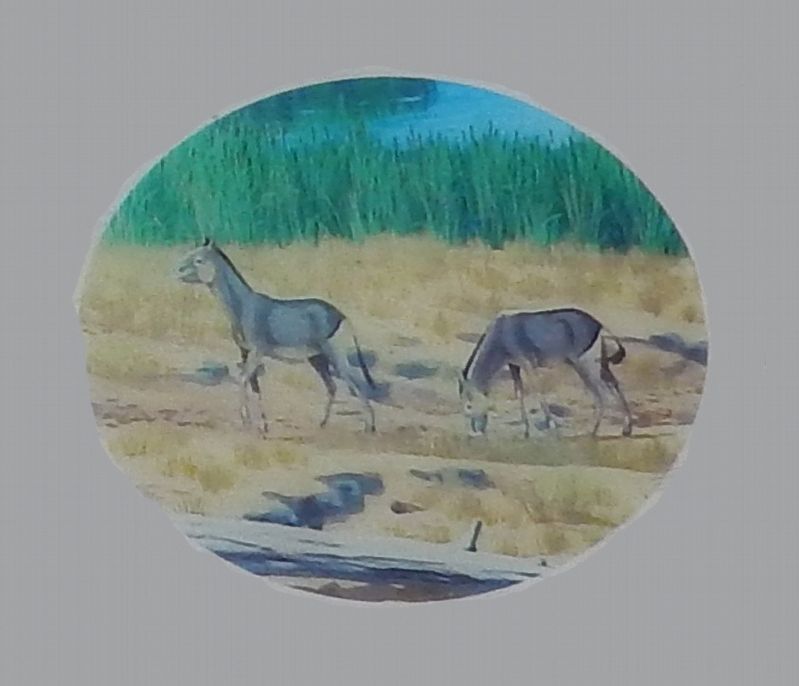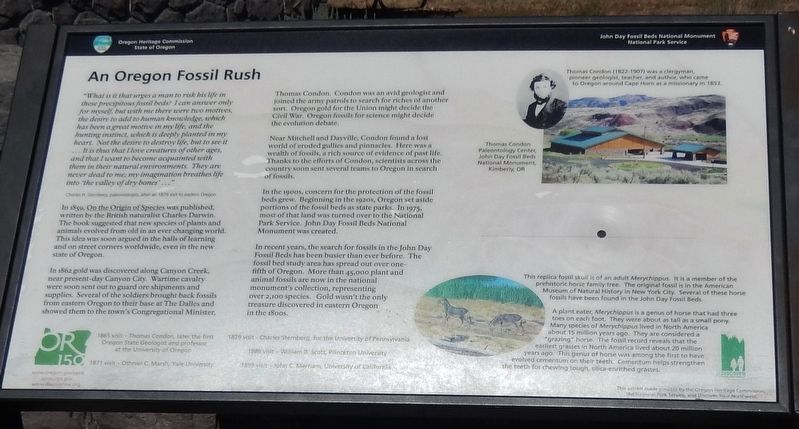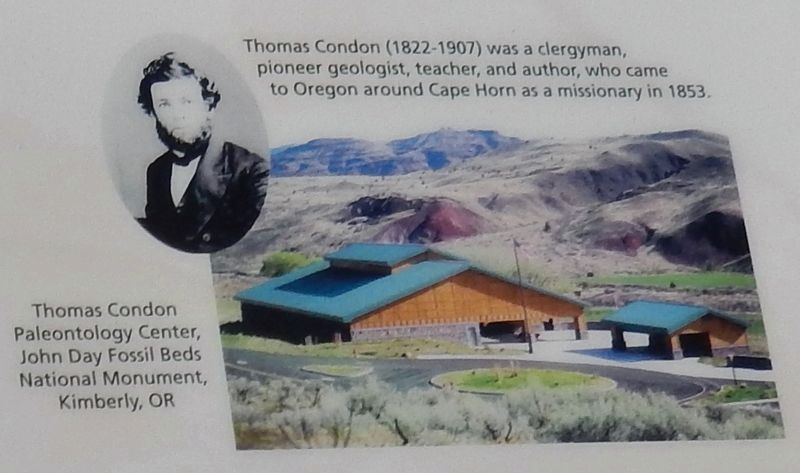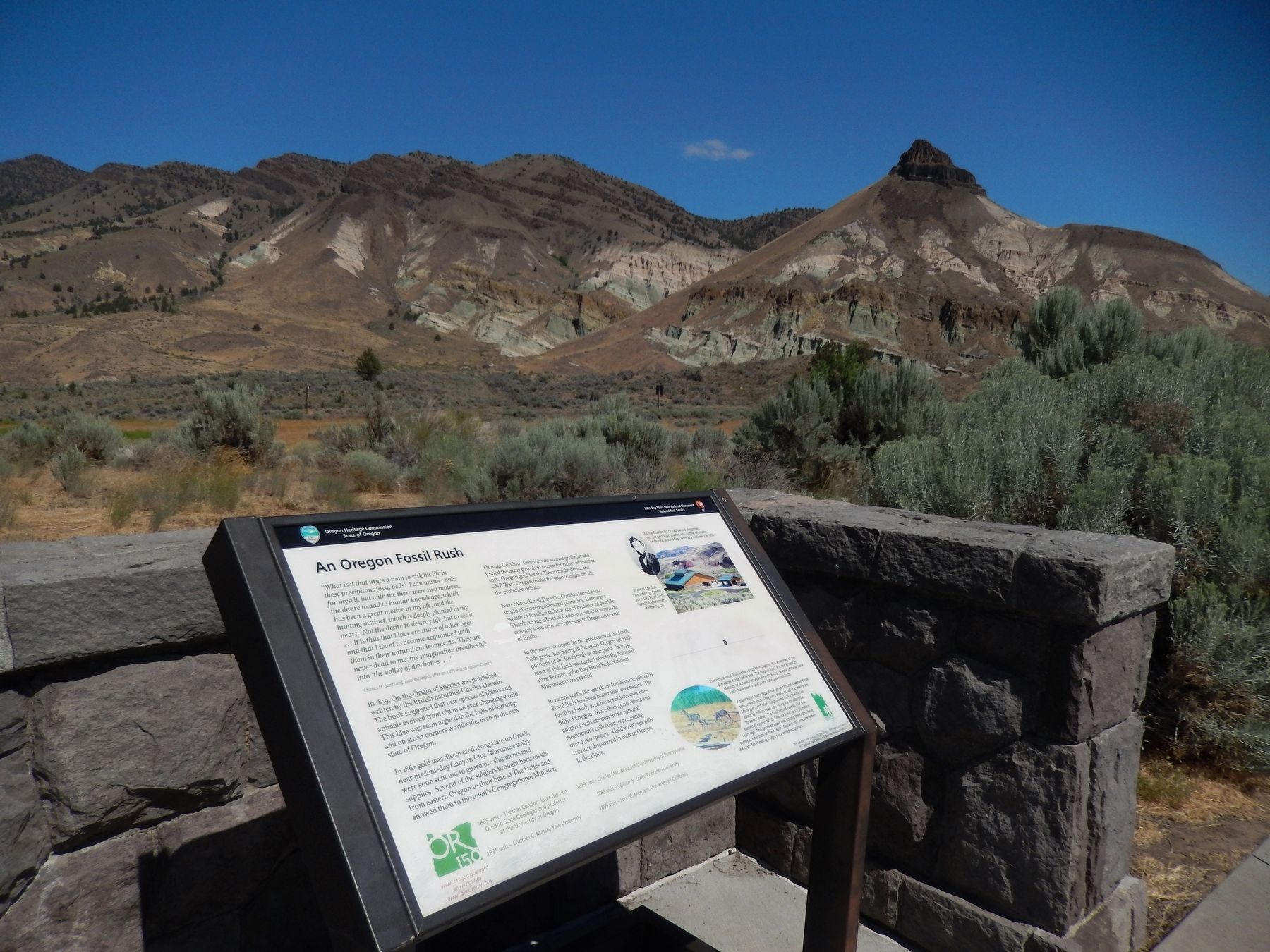Near Dayville in Grant County, Oregon — The American West (Northwest)
An Oregon Fossil Rush
“What is it that urges a man to risk his life in these precipitous fossil beds? I can answer only for myself, but with me there were two motives, the desire to add to human knowledge, which has been a great motive all my life, and the hunting instinct, which is deeply planted in my heart. Not the desire to destroy life, but to see it… It is thus that I love creatures of other ages, and that I want to become acquainted with them in their natural environments. They are never dead to me; my imagination breathes life into ‘the valley of dry bones’ …”
Charles H. Sternberg, paleontologist, after an 1879 visit to eastern Oregon
In 1859, On the Origin of Species was published, written by the British naturalist Charles Darwin. The book suggested that new species of plants and animals evolved from old in an ever changing world. This idea was soon argued in the halls of learning and on street corners worldwide, even in the new state of Oregon.
In 1862 gold was discovered along Canyon Creek, near present-day Canyon City. Wartime cavalry were soon sent out to guard ore shipments and supplies. Several of the soldiers brought back fossils from eastern Oregon to their base at The Dalles and showed them to the town's Congregational Minister, Thomas Condon. Condon was an avid geologist and joined the army patrols to search for riches of another sort. Oregon gold for the Union might decide the Civil War. Oregon fossils for science might decide the evolution debate.
Near Mitchell and Dayville, Condon found a lost world of eroded gullies and pinnacles. Here was a wealth of fossils, a rich source of evidence of past life. Thanks to the efforts of Condon, scientists across the country soon sent several teams to Oregon in search of fossils.
In the 1900s, concern for the protection of the fossil beds grew. Beginning in the 1920s, Oregon set aside portions of the fossil beds as state parks. In 1975, most of that land was turned over in the National Park Service. John Day Fossil Beds National Monument was created.
In recent years, the search for fossils in the John Day Fossil Beds has been busier than ever before. The fossil bed study area has spread out over one-fifth of Oregon. More than 45,000 plant and animal fossils are now in the national monument's collection, representing over 2,100 species. Gold wasn’t the only treasure discovered in eastern Oregon in the 1800s.
1865 visit – Thomas Condon, later the first Oregon State Geologist and professor at the University of Oregon
1871 visit – Othniel C. Marsh, Yale University
1879 visit – Charles Sternberg, for
the University of Pennsylvania
1889 visit – William B. Scott, Princeton University
1899 visit – John C. Merriam, University of California
Erected by Oregon Heritage Commission & National Park Service.
Topics. This historical marker is listed in these topic lists: Paleontology • Settlements & Settlers.
Location. 44° 33.15′ N, 119° 38.757′ W. Marker is near Dayville, Oregon, in Grant County. Marker can be reached from John Day Highway (Oregon Route 19) 2 miles north of U.S. 26, on the left when traveling north. Marker is located at the Thomas Condon Paleontology Center, at the north end of the parking lot. Touch for map. Marker is in this post office area: Dayville OR 97825, United States of America. Touch for directions.
Other nearby markers. At least 8 other markers are within walking distance of this marker. On the Road of History (approx. 0.2 miles away); James Cant Ranch Historic District (approx. 0.2 miles away); The Shearing Done (approx. 0.2 miles away); a different marker also named James Cant Ranch Historic District (approx. 0.2 miles away); Welcome to the John Day River (approx. 0.2 miles away); Lifeblood of a Ranch (approx. ¼ mile away); Haystacker (approx. ¼ mile away); Shearing the Sheep (approx. ¼ mile away). Touch for a list and map of all markers in Dayville.
Also see . . .

Photographed By Cosmos Mariner, June 29, 2016
3. Marker detail:
This replica fossil skull is of an adult Merychippus.
It is a member of the prehistoric horse family tree.
The original fossil is in the American Museum of Natural History in New York City.
Several of those horse fossils have been found in the John Day Fossil Beds.
A plant eater, Merychippus is a genus of horse that had three toes on each foot. They were about as tall as a small pony. Many species of Merychippus lived in North America about 15 million years ago. They are considered a “grazing” horse. The fossil record reveals that the earliest grasses in North America lived about 20 million years ago. This genus of horse was among the first to have evolved cementum on their teeth. Cementum helps strengthen the teeth for chewing tough, silica-enriched grasses.
A plant eater, Merychippus is a genus of horse that had three toes on each foot. They were about as tall as a small pony. Many species of Merychippus lived in North America about 15 million years ago. They are considered a “grazing” horse. The fossil record reveals that the earliest grasses in North America lived about 20 million years ago. This genus of horse was among the first to have evolved cementum on their teeth. Cementum helps strengthen the teeth for chewing tough, silica-enriched grasses.
In 1865, Condon visited the basin for the first time with the First Oregon Cavalry and started excavating fossils. The specimens he sent to museums on the East Coast for verification ignited scientific interest, and he donated a selection of his specimens to the Smithsonian Institution. In recognition of his scientific work, Condon was appointed the first Oregon State Geologist in 1872. He would later become a professor of geology at the University of Oregon where he held that position until his death in 1907. (Submitted on February 15, 2018, by Cosmos Mariner of Cape Canaveral, Florida.)
Credits. This page was last revised on February 16, 2018. It was originally submitted on February 15, 2018, by Cosmos Mariner of Cape Canaveral, Florida. This page has been viewed 218 times since then and 25 times this year. Photos: 1, 2, 3, 4. submitted on February 15, 2018, by Cosmos Mariner of Cape Canaveral, Florida. • Andrew Ruppenstein was the editor who published this page.


